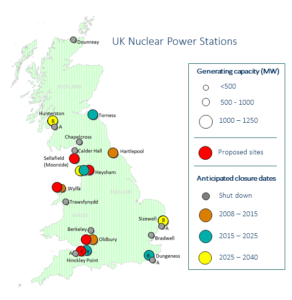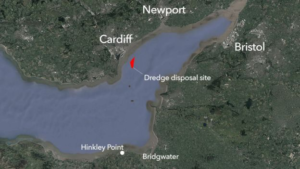Toxic Dumping In The UK
The concept of nuclear waste being dumped in the UK may sound like something out of science fiction or an episode of The Simpsons, however this is in fact not a new phenomenon in the UK and the consequences may be more severe on the UK’s environment than the occasional three eyed fish.
There is growing concern and anger among campaigners in South Wales, as 300,000 tonnes of potentially radioactive sludge are due to be disposed of on the Cardiff Grounds sandbank. This sediment is due to be dredged from the seabed near the Hinkley Point C plant, as EDF Energy and China General Nuclear Power Corporation (CGN) are set to build two new nuclear reactors at the Somerset site, which is situated in the Bristol channel. There are concerns that the potentially radioactive mud has not been appropriately tested and could degrade and release particles which could be damaging to human health and the environment (BBC News, 20181).
Nuclear waste in the UK
The UK currently has fifteen operational nuclear power plants, the power from which amounts to almost a quarter of the country’s electricity, as of 2016. This number is projected to increase by up to a third by 2035 (World-nuclear.org, 2018). Last month, Chris Huhne the Secretary for Energy, announced an estimated £18 billion project for the building of eight new nuclear power stations in an attempt to cut carbon emissions (Gray, 2018). There is a great deal of concern and apprehension around the topic of nuclear power, especially when considering the well-known disasters of Fukushima and Chernobyl.

In the UK, the Office for Nuclear Regulation (known as ONR) regulates the 37 licensed nuclear sites (Onr.org.uk, 2018). Thankfully, there has not to date been any considerable disasters within the British nuclear industry, although there have been historic controversies with the dumping of nuclear waste (No2NuclearPower, 2018). In general the environmental impacts of nuclear power are harder to detect and relatively low when compared to other types of fossil power (International Panel on Fissile Materials, 2018). However, it is well known that nuclear waste can be damaging towards the environment, as it can affect the air and water, microorganisms, pests, germs, plants, birds and all forms of life in our ecosystem, which can also lead to human ingestion (Ali et al, 2015). Moreover, exposure can lead to cancer and birth defects, these horrific symptoms were sadly felt by the cleanup crew and the surrounding 6.5 million people who were in close proximity to Chernobyl (National Cancer Institute, 2018). Justifiably, there is a lot of bad press when concerning nuclear power and there is a tendency for governments to continue to go on quietly operating these huge sources of pollution without the public asking where does the waste go? And maybe it is time to ask whether these potentially huge sources of environmental degradation are really necessary as we approach 2020?
What is happening in Wales?

The current debate in Cardiff concerns suitable testing of the potentially nuclear sludge which is being dumped in close proximity to the Cardiff bay area. The government maintains the stance that the sludge from the Hinkley Point C nuclear power plant has been sufficiently tested and causes no risk to the environment. However, “The Campaign Against Hinkley Mud Dumping”, which include an eclectic group of scientists, some surfers and a rock star (the keyboard player from Super Furry Animals), believe that the waste has not been suitably tested and could indeed be a risk to human health and the environment.
Professor Keith Barnham (Emeritus Professor of Physics, and Distinguished Research Fellow at Imperial College, London) said on the record that:
“Hinkley Point A was used to produce raw materials for nuclear bombs in the late 1960s. Magnox Ltd has admitted also that many “de-splitting” accidents in the Magnox cooling ponds resulted in spent fuel in the sludge. EDF should have tested for alpha emitters prior to the dumping. Leaks from fuel pins at Hinkley Point were certainly not rare.” (Rowe, 2018).
This argument has been echoed by Neil McEvoy, Member of the Welsh Assembly for South Wales Central in the Assembly chamber; he read a statement in which he quoted Professor Keith Barnham. In layman’s terms, campaigners were calling for more extensive alpha testing and mass spectrometry testing of the sediment not just the gamma testing which was carried out. Gamma rays are often considered the most dangerous type of radiation and alpha the weakest as the rays are not able to penetrate human skin, however alpha rays can still be damaging when inhaled or ingested (Co.monmouth.nj.us, 2018). The campaigners believe that no appropriate environmental impact assessment had been carried out and have sought legal action against the dumping (Morris, 2018). Furthermore, in September (2018), Judge Milwyn Jarman stated that it must be clarified whether dumping the mud from near a nuclear plant is covered by an environmental impact assessment (BBC News, 20182).
This standpoint has been fiercely denied by the government and both developers EDF and Natural Resources Wales (NRW). To begin to understand the argument presented by them, you have to consider that the majority of mankind’s exposure to radiation comes through natural sources and we all naturally come into contact with radiation in our everyday lives (UN, 1988). The research presented by EDF Energy stated that combining natural and artificial levels of radioactivity together, any exposure from the potentially radioactive sludge from Hinkley point C would be 10,000 times less than an airline pilot’s annual dose, 750 times less than the average dose received by a resident of Pembrokeshire due to naturally occurring radon gas, and the equivalent to the average person eating 20 bananas each year (BBC3, 2018). The campaigners disagree, stating that without alpha ray and mass spectrometry testing the true levels of exposure and any negative ramifications from the potentially radioactive sludge remain unknown.
The future of nuclear waste in the UK
Calls to halt the dumping of the “nuclear waste” have comprehensively been denied by the Welsh Assembly, and Ms Lesley Griffiths, the Environment Secretary in a damning statement, accused campaigners as circulating lies (BBC News. 2018)4. Subsequently, the campaign group has agreed to discontinue legal action after the vote from the Assembly (BBC News. 2018)5. However, considering the UK’s determination to continue to focus on nuclear power as a viable strategy to reduce greenhouse gases, maybe it is now time to consider where this extra nuclear waste is going to go?
The implications of harm to the environment from exposure to nuclear waste and the correct way of disposing of it is not universally accepted (Yeager and Shrader-Frechette, 1994). The UK has a long history of burying nuclear waste (No2NuclearPower, 2018), and this is a strategy which the government is not going to change. Recently, a committee of MPs have backed proposals which could lead to nuclear waste being permanently buried under Areas of Outstanding Natural Beauty and National Parks (Carrington, 2018). Therefore, the future of environmental intelligence and potential contamination in the UK’s environment may be more complex and convoluted in years to come.
References
BBC News. (2018)1. Hundreds in nuclear mud dump protest. [online] Available at: https://www.bbc.co.uk/news/uk-wales-45322712 [Accessed 30 Oct. 2018].
Ali, S.H.A., Iqbal, A. and Awan, M,S (2015) Nuclear Waste and Our Environment. American Journal of Social Science Research Vol. 1, No. 2, 2015, pp. 114-120 Available at: http://www.aiscience.org/journal/ajs [Accessed 16 Nov. 2018].
BBC News. (2018)2. Toxic mud dump claim ‘alarmist’. [online] Available at: https://www.bbc.co.uk/news/uk-wales-42226392 [Accessed 23 Oct. 2018].
BBC News. (2018)3. Campaigners drop Hinkley mud challenge. [online] Available at: https://www.bbc.co.uk/news/uk-wales-45718810 [Accessed 23 Oct. 2018].
BBC News. (2018)4. Call to stop nuclear plant mud dump fails. [online] Available at: https://www.bbc.co.uk/news/uk-wales-politics-45811491 [Accessed 30 Oct. 2018].
BBC News. (2018)5. Campaigners drop Hinkley mud challenge. [online] Available at: https://www.bbc.co.uk/news/uk-wales-45718810 [Accessed 30 Oct. 2018].
Carrington, D. (2018). Allow nuclear waste disposal under national parks, say MPs. [online] the Guardian. Available at: https://www.theguardian.com/environment/2018/jul/31/allow-nuclear-waste-disposal-in-national-parks-say-mps?CMP=share_btn_fb&fbclid=IwAR3WCyUmnHDjD6YoOlAZS5_VzWkoUfmRT1pC95EwtDDriZs65bqjarNyd7k [Accessed 30 Oct. 2018].
Co.monmouth.nj.us. (2018). [online] Available at: http://co.monmouth.nj.us/documents/118%5CRADIATION%20HEALTH%20BASICS.pdf [Accessed 16 Nov. 2018].
Gray, L. (2018). Eight new nuclear power stations despite safety and clean-up concerns. [online] Telegraph.co.uk. Available at: https://www.telegraph.co.uk/news/earth/energy/8070810/Eight-new-nuclear-power-stations-despite-safety-and-clean-up-concerns.html [Accessed 23 Oct. 2018].
International Panel on Fissile Materials (September 2010). “The Uncertain Future of Nuclear Energy” (PDF). Research Report 9. p. 1.
Morris, S. (2018). Welsh leaders urged to halt ‘nuclear mud’ dumping off Cardiff. [online] the Guardian. Available at: https://www.theguardian.com/uk-news/2018/oct/02/hinkley-point-c-nuclear-mud-case-dropped-after-debate-secured [Accessed 23 Oct. 2018].
National Cancer Institute. (2018). Accidents at Nuclear Power Plants and Cancer Risk. [online] Available at: https://www.cancer.gov/about-cancer/causes-prevention/risk/radiation/nuclear-accidents-fact-sheet?redirect=true [Accessed 16 Nov. 2018].
No2NuclearPower. (2018). History of nuclear waste disposal proposals in Britain. [online] Available at: http://www.no2nuclearpower.org.uk/radwaste/history-of-nuclear-waste-disposal-proposals-in-britain/ [Accessed 30 Oct. 2018].
United Nations Scientific Committee on the Effects of Atomic Radiation (1988). Exposures from natural sources of radiation. United Nations (UN): UN.
US National Cancer Institute, Accidents at Nuclear Power Plants and Cancer Risk
World-nuclear.org. (2018). Nuclear Power in the United Kingdom |UK Nuclear Energy – World Nuclear Association. [online] Available at: http://www.world-nuclear.org/information-library/country-profiles/countries-t-z/united-kingdom.aspx [Accessed 23 Oct. 2018].
Yeager, P. and Shrader-Frechette, K. (1994). Burying Uncertainty: Risk and the Case Against Geological Disposal of Nuclear Waste. Contemporary Sociology, 23(5), p.691.